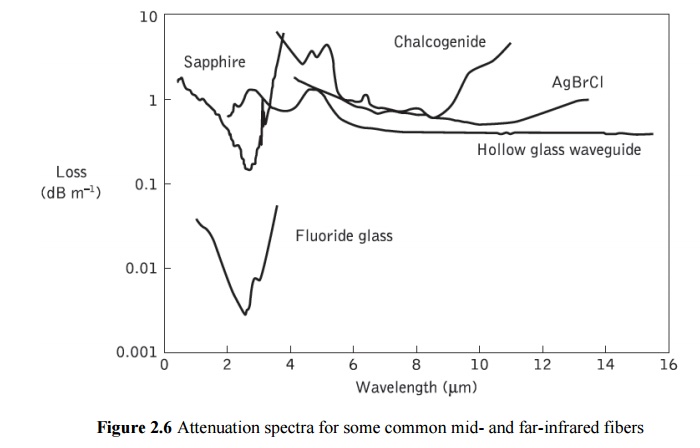Chapter: Optical Communication and Networking : Transmission Characteristics of Optical Fiber
Mid infrared and far infrared transmission
Mid-infrared and far-infrared
transmission
In the
near-infrared region of the optical spectrum, fundamental silica fiber
attenuation is dominated by Rayleigh scattering and multiphonon absorption from
the infrared absorption edge (see Figure 2.2). Therefore, the total loss
decreases as the operational transmission wavelength increases until a
crossover point is reached around a wavelength of 1.55 μm where the total fiber
loss again increases because at longer wavelengths the loss is dominated by the
phonon absorption edge. Since the near fundamental attenuation limits for
near-infrared silicate class fibers have been achieved, more recently
researchers have turned their attention to the mid-infrared (2 to 5 μm) and the
far-infrared (8 to 12 μm) optical wavelengths.
In order
to obtain lower loss fibers it is necessary to produce glasses exhibiting
longer infrared cutoff wavelengths. Potentially, much lower losses can be
achieved if the transmission window of the material can be extended further
into the infrared by utilizing constituent atoms of higher atomic mass and if
it can be drawn into fiber exhibiting suitable strength and chemical
durability. The reason for this possible loss reduction is due to Rayleigh
scattering which displays a λ−4 dependence and hence becomes much reduced as
the wavelength is increased. For example, the scattering loss is reduced by a
factor of 16 when the optical wavelength is doubled.
Thus it
may be possible to obtain losses of the order of 0.01 dB km−1 at a wavelength
of 2.55 μm, with even lower losses at wavelengths of between 3 and 5 μm.
Candidate glass-forming systems for mid-infrared transmission are fluoride,
fluoride–chloride, chalcogenide and oxide.

In
particular, oxide glasses such as Al2O3 (i.e. sapphire) offer a near equivalent
transmittance range to many of the fluoride glasses and have benefits of high
melting points, chemical inertness, and the ability to be readily melted and
grown in air. Chalcogenide glasses, which generally comprise one or more
elements Ge, Si, As and Sb, are capable of optical transmission in both the
mid-infrared and far-infrared regions.
A typical
chalcogenide fiber glass is therefore arsenide trisulfide (As2S3). However,
research activities into far-infrared transmission using chalcogenide glasses,
halide glasses, polycrystalline halide fibers (e.g. silver and thallium) and
hollow glass waveguides are primarily concerned with radiometry, infrared
imaging, optical wireless, optical sensing and optical power transmission
rather than telecommunications
The loss
spectrum for a single-crystal sapphire fiber which also transmits in the
midinfrared is also shown in Figure 2.6. Although they have robust physical
properties, including a Young’s modulus six times greater as well as a thermal
expansion some ten times higher than that of silica, these fibers lend
themselves to optical power delivery applications [Ref. 27], not specifically
optical communications. Chalcogenide glasses which have their lowest losses
over both the mid- and far-infrared ranges are very stable, durable and insensitive
to moisture. Arsenic trisulfide fiber, being one of the simplest, has a
spectral range from 0.7 to around 6 µm. Hence it has a cut off at long
wavelength significantly before the chalcogenide fibers containing heavier
elements such as Te, Ge and Se, an attenuation spectrum for the latter being
incorporated in Figure 2.6. In general, chalcogenide glass fibers have proved
to be useful in areas such as optical sensing, infrared imaging and for the
production of fiber infrared lasers and amplifiers.
Related Topics